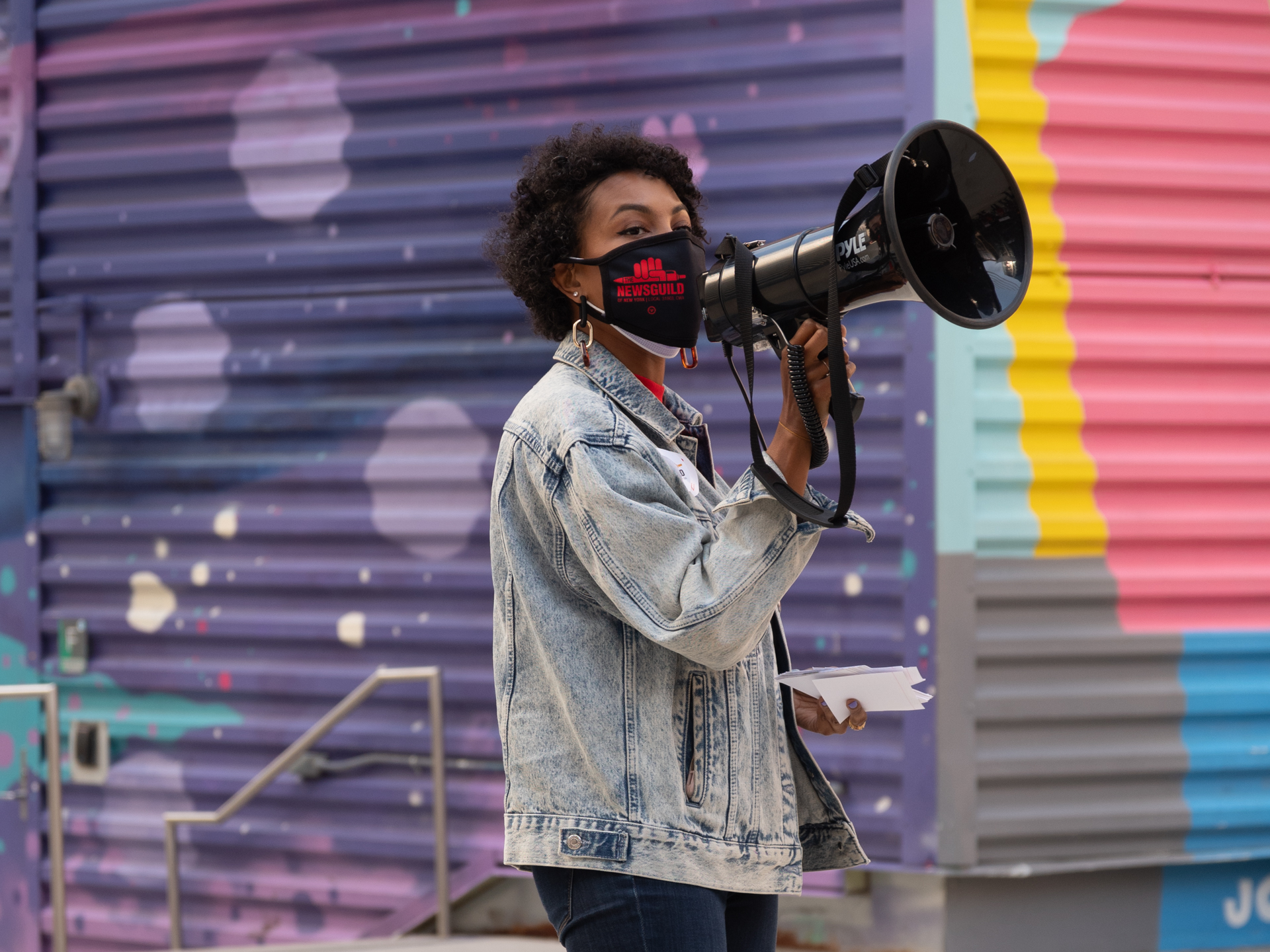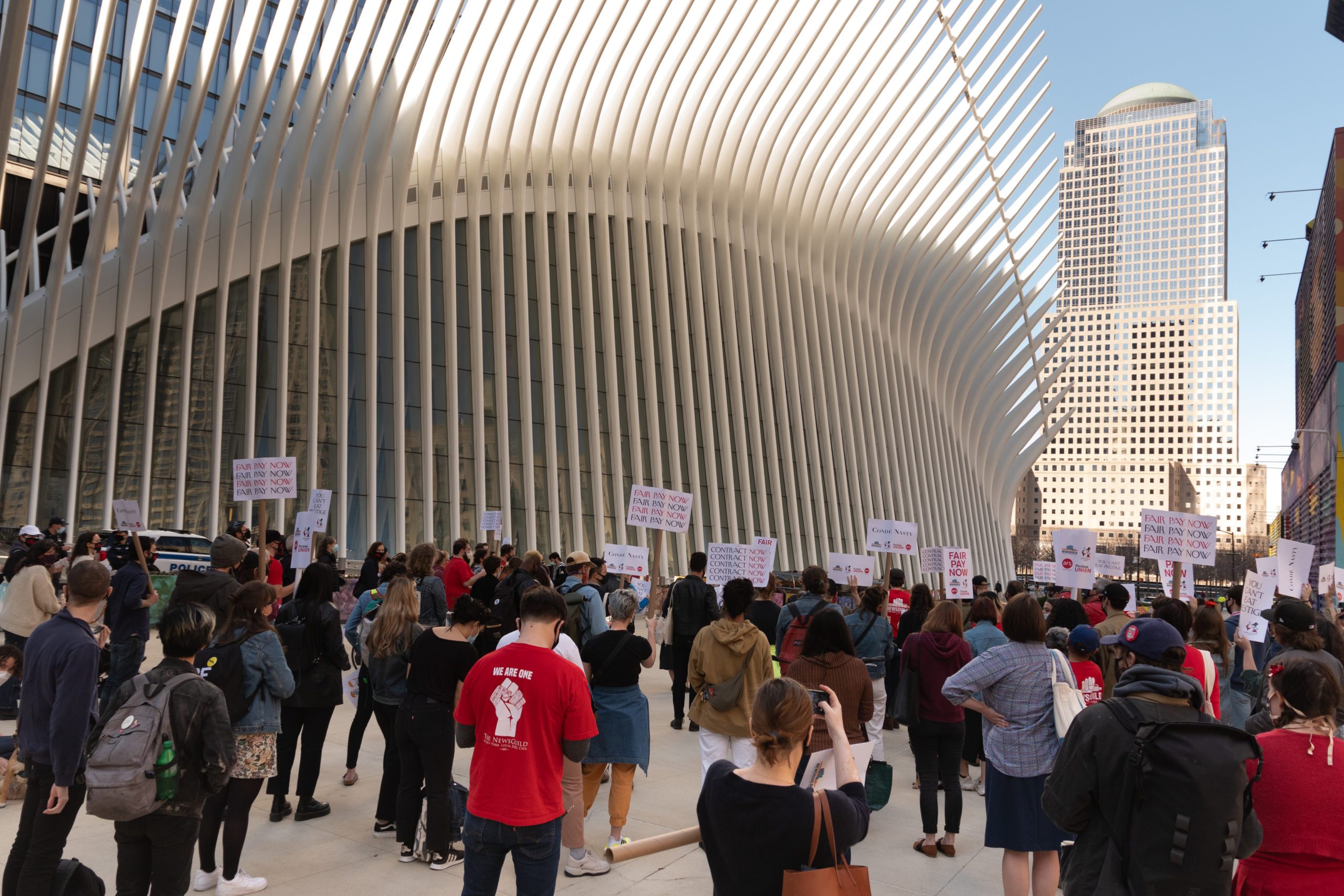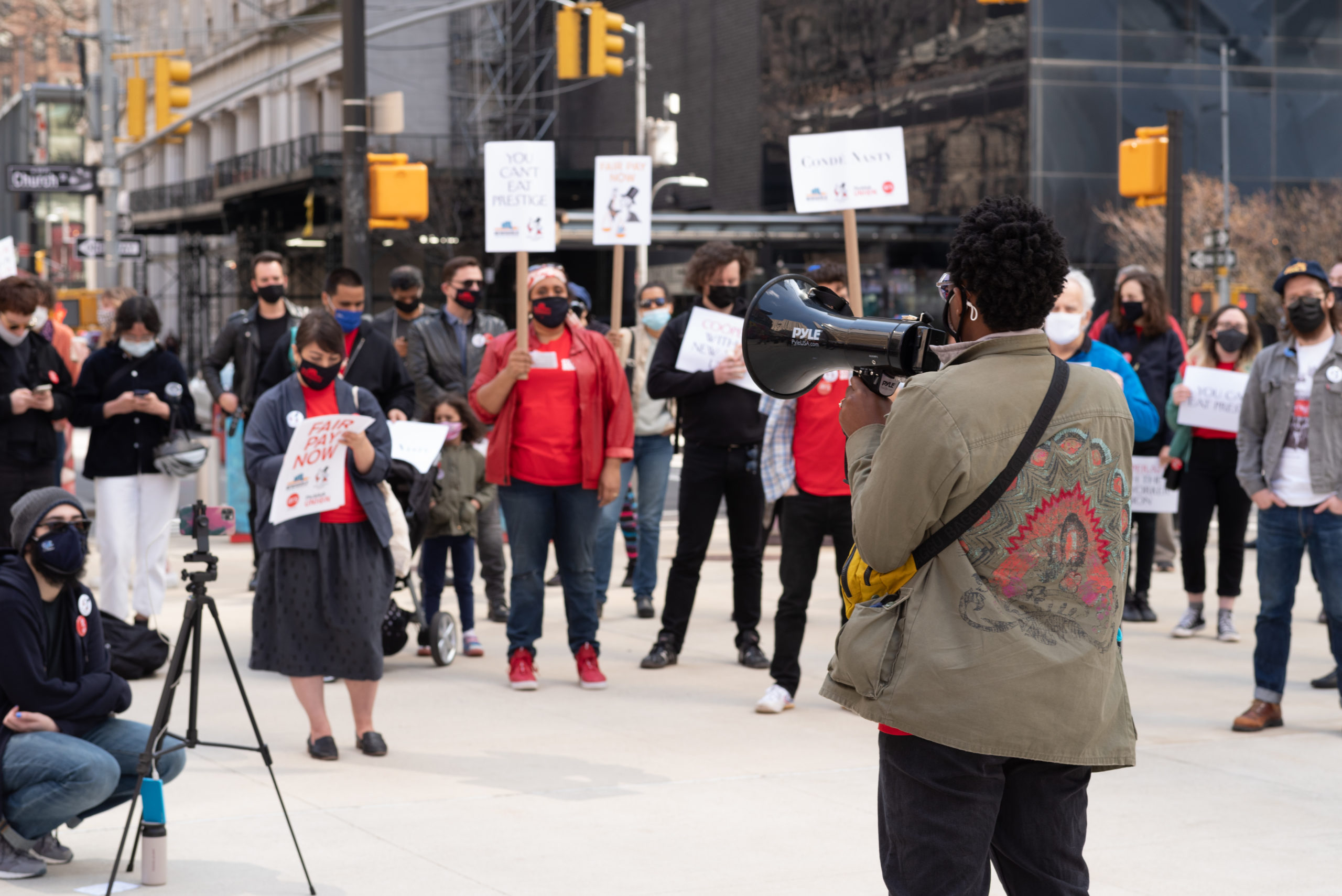One day after announcing that 98% of their members had voted to authorize a strike, workers and supporters of the New Yorker Union, Pitchfork Union and Ars Technica Union gathered outside Condé Nast’s headquarters at One World Trade Center for a rally.
Between chants of “the status quo has got to go” and “our union united will never be divided,” union leaders, workers and local public figures gave speeches to the crowd of Condé Nast employees. It was a fitting demonstration of unity — and not just because the three bargaining units had jointly announced a strike authorization vote the day before.
For two years, the three Condé Nast unions had worked together, coordinating announcements and sharing updates from their individual bargaining sessions. They first publicly came together on March 29, 2019, to reveal union drives at Pitchfork and Ars Technica. Nearly two years later to the day, they announced that they were prepared to strike if Condé Nast didn’t start negotiating in good faith.
Though the New Yorker newsroom unionized 10 months prior to Pitchfork and Ars Technica, all three have reached a similar point in their negotiations for a first contract. Much of the discussion at the bargaining tables over the past two months has centered on economic proposals.
“Because our bargaining timelines are so close — we’re all in the middle of wages discussions and have gotten multiple counterproposals from Condé — we could coordinate this vote at the same time in the hopes that it really amplified the message to Condé Nast management as well as the individual brand management,” Ars Technica Union vice chair Nathan Mattise said.
Condé Nast’s fourth unionized newsroom, Wired, did not seek a strike authorization vote because its unit has not yet started bargaining. But members of Wired Union signed a statement in support of the other three units.
The vote gives the bargaining committees of the New Yorker, Ars Technica and Pitchfork unions the power to call a strike if they deem it necessary to push negotiations along. The unions are not yet on strike.
Negotiations over wages have been contentious. In January, the New Yorker Union made headlines when it held a one-day work stoppage after management countered the union-proposed $65,000 wage floor with a $45,000 salary minimum. (It has since revised its counterproposal to $50,000.)
“I couldn’t even pay attention to what’s happening at the table because I just couldn’t believe what I was seeing,” said New Yorker Union chair Natalie Meade, describing the moment she saw the initial counterproposal. “It just seemed like almost a slap in the face.”
Two months later, the unions say that Condé Nast continues to fail to negotiate in good faith, seeking instead to “maintain unilateral control” and “memorialize the status quo.” Both the Pitchfork and Ars Technica unions have received responses to their own wage proposals and have called those counterproposals “abysmal” and “insulting.”
“In some cases, management’s proposals would make the terms and conditions of our employment even worse; currently, they are proposing annual wage increases so small that salaries would not even keep up with the rate of inflation,” the unions wrote Friday in their announcement explaining why they had sought a strike authorization vote.
A Condé Nast spokesperson wrote in an emailed statement that recent bargaining sessions have led to progress in reaching tentative agreements on certain issues.
“Over the course of negotiations, The New Yorker, Pitchfork, Ars Technica, and their respective unions have reached agreement on issues ranging from Just Cause to additional paid time off to training and professional development. On wages and economics, management has proposed giving raises to everyone in these bargaining units; increasing minimum salaries for entry-level employees by nearly 20%; and providing guaranteed annual raises for all members, among other enhancements,” the spokesperson wrote.
“All of this has been accomplished in just two rounds of bargaining, as we first received the unions’ economic proposals at the end of last year. We look forward to seeing this process through at the bargaining table.”
Condé Nast is one of the most famous media companies in the world, publishing magazines like Vogue, GQ and Vanity Fair. Though the vast majority of its 26 brands do not have unions, the four that are unionized have attracted considerable attention.
The New Yorker Union was the first, going public in 2018, on the heels of a wave of unionization that swept through digital publications and legacy news outfits alike. Ars Technica and Pitchfork followed in 2019, and Wired’s union was recognized in 2020, eight months after it had announced its intent to unionize.
The road to unionization can be rocky — the path to a first contract even more so. But the past three years have been particularly intense as the four units have clashed with Condé Nast over everything from contract proposals to layoffs. Some of the most high-profile incidents have been led by the New Yorker Union, including January’s work stoppage and a digital picket of the New Yorker Festival last year that earned the support of Rep. Alexandria Ocasio-Cortez (D-N.Y.) and Sen. Elizabeth Warren (D-Mass.).
Though union leaders describe Condé Nast as “siloed” with work interactions across the brands relatively rare for the average employee, the units have found their way to each other, sharing advice and talking negotiation strategy.
That collaboration between the brands is natural, according to Susan DeCarava, the president of the NewsGuild of New York, of which all four units are a part.
“Organizing leads to more organizing,” DeCarava said. “That is a fundamental truism of this work.”

New Yorker Union unit chair Natalie Meade addresses the crowd at a “Solidarity Rally” held Saturday in support of the Condé Nast unions. “We demand that the New Yorker and Condé Nast return to the bargaining table expeditiously and that they negotiate in good faith. Otherwise, they will feel the weight of our union like never before.” (Tim Try/The NewsGuild of New York)
The media industry has transformed dramatically in the last decade, and Condé Nast has been no exception. Ultimately it was that uncertainty that prompted several of the brands to unionize.
In 2018, after Condé Nast posted a loss of $120 million the previous year, the company underwent a large restructuring that led to departments being cut and recombined across brands. The New Yorker escaped unscathed, but workers there decided that unionizing would help protect their jobs in the future, Meade said.
“We were grateful for our managers for fighting that off, but we also felt like a union was a good way to protect us as workers as Condé would have arbitrary layoffs,” Meade said. “People in our magazine would have lost a job without really knowing why. People were tired of these low wages, and people wanted more job security.”
Over at Ars Technica, the newsroom was reeling from the layoffs of two of its staff. Mattise, who has been at Ars Technica since 2012, said that the small newsroom had largely avoided the effects of Condé Nast’s financial woes up until then. But those layoffs helped start conversations about unionization.
“Somebody joked in the Slack around the time — at that point Condé Nast was having financial issues, there were cuts coming across the board — if GQ is sick, the rest of us catch a cold,” Mattise said. “It was the first time that the global financial struggles of the company, or global cuts of the company, really came home to our small Ars organization, and we sat there and realized this could happen to any of us at any time.”
At the same time, Pitchfork employees were also organizing. Unit leader Ryan Dombal said the departure of their executive editor — who had worked at Pitchfork for 20 years, eight of those as executive editor — had left the newsroom feeling vulnerable.
As part of their organizing, both Ars Technica and Pitchfork staff reached out to the NewsGuild of New York. The union connected the two, and soon they were coordinating with each other. They decided to announce their new unions at the same time in March 2019.
“We were a little ahead of Pitchfork when it came to being ready to go public, but we were happy to delay because going public by ourselves would be just a little splash. But us going public at the same time as Pitchfork would have an outsized effect,” Mattise said.
Discussions about unionization at Wired started in late 2018, but the three other Condé Nast unions inspired the Wired staff to move forward, said unit chair Lily Hay Newman.
The New Yorker Union, especially, showed that unionization at Condé Nast was achievable. The very structure of Condé Nast — each brand working separately — had made unionizing seem almost impossible, Newman said.
“There isn’t a lot of communal, collaborative feeling across the company,” Newman said. “So when you think about your own magazine, it feels tough to know where to start.”
The path to getting Wired’s union recognized was especially difficult as Condé Nast argued that nearly 20 of their colleagues should not be included in the union. Those staff, which include certain writers and audience development team members, work closely with Wired staff but are not paid through the Wired budget, Newman said.
The two sides ultimately decided to defer the issue to bargaining, and Wired was voluntarily recognized in December 2020. They have not yet started contract negotiations.

Members and supporters of the Condé Nast unions rally outside One World Trade Center, which houses Condé Nast’s New York headquarters. (Tim Try/The NewsGuild of New York)
The strike authorization announcement was not the first time the units have publicly clashed with Condé Nast.
The dispute that has drawn perhaps the most attention was the argument over a “just cause” proposal that The New Yorker, Ars Technica and Pitchfork unions wanted in their contracts. In general, “just cause” clauses establish a standard that management must meet before disciplining or firing an employee.
As part of their campaign to get “just cause,” the New Yorker Union launched a half-day work stoppage last summer. They also hung up posters in the office and organized a letter-writing campaign to editor David Remnick. When that didn’t work, they wrote an open letter to Remnick that garnered more than 2,000 signatures.
“Nothing worked. Nothing worked at all, and it was really upsetting,” Meade said. “All of those attempts that sort of went unacknowledged was the reason that we chose to picket the New Yorker Festival.”
The festival is an annual tradition that brings together influential political and cultural figures. The 2020 lineup included National Institute of Allergy and Infectious Diseases director Anthony S. Fauci, writer Margaret Atwood, cellist Yo-Yo Ma, and actor Maya Rudolph, among others.
The keynote speakers scheduled for the first night were Sen. Warren and Rep. Ocasio-Cortez, but the two politicians pulled out in support of the union and its digital picket. Former Attorney General Eric Holder also withdrew his participation.
Warren’s and Ocasio-Cortez’s actions helped bring the union’s fight into the national spotlight. Just six days later, the union announced it had successfully negotiated a tentative agreement granting New Yorker employees “just cause” protection.
In a statement to CNN Business at the time, a New Yorker spokesperson wrote, “We are pleased that The New Yorker’s management has reached a tentative agreement with the New Yorker Union on a number of issues. The compromise we arrived at includes Just Cause, a principle insuring job security, and keeps editorial standards and judgments in the hands of the magazine.”
Soon after, the Pitchfork and Ars Technica unions secured their own “just cause” tentative agreements. Leaders at both unions credited the New Yorker Union for paving the way.
“‘Just cause’ discussions at the bargaining table didn’t really start in earnest until after what happened at the New Yorker, so we were able to kind of really benefit from the groundwork they had done,” Mattise said. “Essentially the thinking was that if Condé Nast was extending that to one brand, there’s no way they could withhold it from the other brand, and it was just a matter of time.”
The three units in the bargaining process regularly communicate to coordinate their negotiation efforts. Though each unit has individual concerns, there are some issues that apply across the board, like health benefits and policies regarding holidays. The unions swap stories about their wins and losses and strategize how best they can push their message across all three bargaining tables.
At a company where each brand operates in individual “silos,” their collaboration represents an attempt to establish new norms across the company, Meade said. As one of her colleagues framed it, “rising tides raise all boats.”
By keeping tabs on how the other two units are progressing, each unit can anticipate Condé Nast’s response to an individual proposal and plan their negotiations accordingly.
“Instead of having to do, OK, here’s proposal one,’ we know they’re going to give us a counterproposal,” Mattise said. “Our bargaining table can start right at proposal two to try to carry the ball forward.”
The units have pushed for joint bargaining sessions, Meade said, and presented management with a list of issues that could be bargained across all three units. But Condé Nast declined. Meade said she is unsure which brands objected to the idea.
Still, a win at one bargaining table doesn’t automatically translate into a win at another table, Dombal said.
“There are little differences between some of our proposals, so it’s not as clear cut as they agree to this thing with the New Yorker, they automatically agree everywhere else,” Dombal said. “I think it’s probably helped, but it’s not as clear as that.”

New Yorker fact checker Shirley Ngozi Nwangwa explains to attendees at a union rally on Saturday why she supports the strike authorization: “I voted yes for our strike authorization because I’m tired of feeling the weight of intimidation on my shoulders.” (Tim Try/The NewsGuild of New York)
Progress in contract negotiations has slowed in recent months, ever since the unions have put forth their economic proposals, Mattise said. In the three unions’ joint statement, they claim that management has delayed the process by refusing to respond to proposals in a timely manner and showing up to bargaining sessions late or unprepared.
The time it takes to negotiate a first contract varies. Legal news site Law360’s union took nearly two years to get its first contract, while the Blue Ridge NewsGuild, which represents staff at The Daily Progress, ratified its first contract six months after it won its election. Those negotiations took just five days.
The longer it takes to negotiate a contract or tentative agreement, the longer employees have to work under the conditions that caused them to unionize in the first place. Meade said some New Yorker managers have denied staff raises, telling them to wait for the new contract.
“Some of the managers would say, ‘We can’t give raises because of the union,’ or, ‘We can’t give you a promotion because of the union,’ which is patently false,” Meade said. “The union would never block a promotion.”
In addition to higher wages, other common priorities among the units include diversity and inclusion initiatives and pathways for advancement.
“We demand clear paths for professional development, concrete commitments to diversity and inclusion, and a safe and respectful workplace free of harassment,” wrote the unions in their joint announcement. “We demand that the company respect our editorial integrity and our need for work-life balance.”
Each unit has to negotiate with managers not only from their own publication, but also with those from Condé Nast, which can complicate matters. For example, Newman said that in the dispute over which employees could be included in the Wired union, they received pushback not from Wired, but Condé Nast. Similarly, Matisse said he has gotten the impression that some of the changes they are fighting for are things Ars management would not oppose.
Now that the bargaining committees at each unit have the ability to call a strike, the unions hope that negotiations will progress.
“The next month is really pivotal,” Mattise said. “We’re just willing to do whatever it takes, I think that’s the bottom line at this point. We’ve come too far. There’s too many people involved who have a lot at stake, and we can’t just give up.”
"strike" - Google News
March 30, 2021 at 05:04PM
https://ift.tt/3u7mOQY
New Yorker, Pitchfork and Ars Technica unions vote to authorize strike, capping two years of coordination - Poynter
"strike" - Google News
https://ift.tt/2WheuPk
https://ift.tt/2VWImBB
Bagikan Berita Ini














0 Response to "New Yorker, Pitchfork and Ars Technica unions vote to authorize strike, capping two years of coordination - Poynter"
Post a Comment